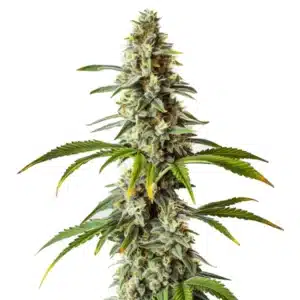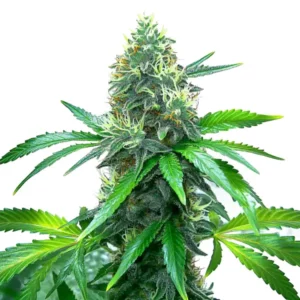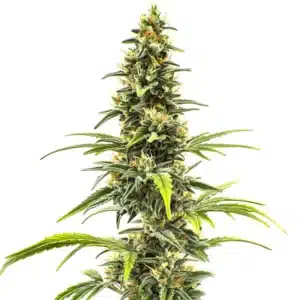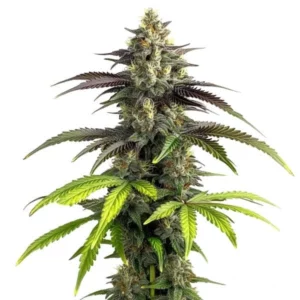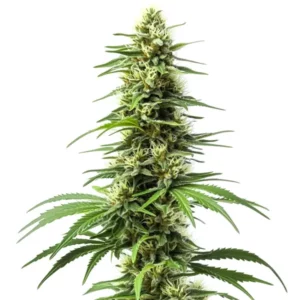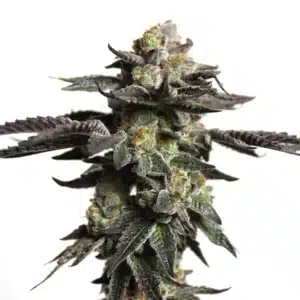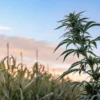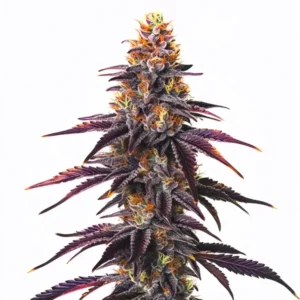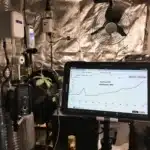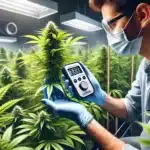
The Link Between VPD and Transpiration in Cannabis
The link between VPD (vapor pressure deficit) and transpiration in cannabis is crucial for growers. VPD is the difference between the amount of moisture in the air and how much moisture the air can hold when it’s fully saturated. This balance affects how cannabis plants lose water through their leaves, a process known as transpiration. Knowing this link helps growers optimize conditions for their plants.
Transpiration is a vital process for cannabis plants. It helps with nutrient uptake, cooling, and overall growth. When VPD levels are optimal, cannabis plants can transpire efficiently. If VPD is too high or too low, it can stress the plants, leading to poor growth or even plant damage. Therefore, managing VPD is essential for healthy cannabis cultivation.
Recommended Strains
Growers often overlook this aspect, but it’s as important as light and nutrients. When VPD is optimized, cannabis plants can thrive. Strains like Diesel, known for its resilience, can particularly benefit from careful VPD management.
How VPD Affects Cannabis Transpiration
The relationship between VPD and cannabis plant water loss is direct. High VPD means the air is dry, encouraging more water loss through transpiration. Low VPD suggests humid air, reducing transpiration rates. Both extremes can have negative vapor pressure deficit effects on cannabis growth.
For instance, when VPD is high, cannabis plants lose water quickly. This rapid loss can lead to wilting, as the plant cannot replace water fast enough. On the other hand, low VPD can cause leaves to remain wet for too long, potentially leading to mold or mildew issues. Balancing VPD ensures cannabis plants maintain healthy transpiration rates.
Knowing the VPD impact on cannabis transpiration rates allows growers to fine-tune their growing environments. By observing plant responses, adjustments can be made to optimize water use efficiency. This knowing is crucial for achieving maximum growth potential and avoiding stress-related issues that can compromise plant health and yield.
Moreover, maintaining appropriate VPD levels is essential for preventing stomatal closure, which can occur under extreme conditions. When stomata close, transpiration is reduced, and nutrient uptake is limited, impacting plant growth. Thus, effective VPD management is a cornerstone of cannabis cultivation, ensuring plants remain vigorous and productive.
Optimizing VPD for Cannabis Transpiration Efficiency
Optimizing VPD for cannabis transpiration efficiency requires careful monitoring and adjustment of environmental conditions. Temperature and humidity are the main factors influencing VPD. By controlling these, growers can adjust the VPD to optimal levels.
- Use a hygrometer to monitor humidity levels in the grow space.
- Adjust temperature with heaters or air conditioning to maintain optimal VPD levels.
- Utilize humidifiers or dehumidifiers to control moisture in the air.
Real-life examples show the effectiveness of these adjustments. A grower cultivating OG Kush noted significant improvements in growth and yield after optimizing VPD. Such adjustments are particularly beneficial during different growth stages, where VPD needs may vary.
Effective cannabis transpiration control through VPD management involves not only adjusting environmental parameters but also knowing the specific requirements of each cannabis strain. By tailoring VPD levels to the genetic needs of the plant, growers can achieve better growth outcomes. This strategy ensures that the microclimate is conducive to the plant’s physiology, enhancing overall plant vigor.
Another important aspect of optimizing VPD is the ability to adapt quickly to changes in weather conditions or plant growth stages. Responsive management allows growers to maintain stability in the growing environment, minimizing stress and maximizing efficiency. This proactive approach is key to achieving high-quality yields and robust plant health.
Promos & Deals
Balancing VPD Throughout Cannabis Growth Stages
The need to balance VPD at different stages of cannabis growth cannot be overstated. Seedlings, vegetative, and flowering stages each have unique requirements. Monitoring and adjusting VPD during these stages can lead to optimal results.
During the seedling stage, lower VPD is often beneficial as young plants are more sensitive to water loss. As the plant enters the vegetative stage, slightly higher VPD supports robust growth. During flowering, maintaining optimal VPD is crucial to prevent bud rot and ensure quality yields.
The link between VPD (vapor pressure deficit) and transpiration in cannabis becomes even more critical during the flowering stage. This period demands precise VPD control to avoid issues such as bud rot, which can severely impact yields and quality. Balanced VPD during flowering ensures that moisture levels are controlled, reducing the risk of fungal diseases.
In the vegetative stage, the relationship between VPD and cannabis plant water loss is essential for promoting vigorous growth. A slightly elevated VPD encourages robust transpiration, facilitating nutrient uptake and growth. This stage sets the foundation for a productive flowering phase, underscoring the importance of stage-specific VPD management.
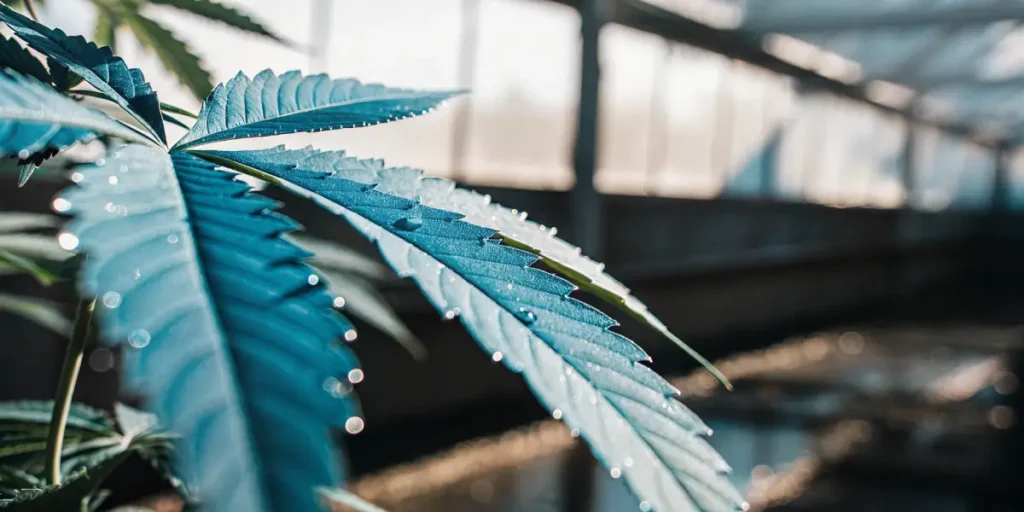
Practical Tips for Managing VPD
Managing VPD effectively involves several practical steps. First, understand the specific needs of your cannabis strain. Different strains, such as Gelato, might have varied VPD requirements. Knowing these can guide your adjustments.
- Regularly check and adjust your grow room’s temperature and humidity.
- Invest in reliable measuring tools for accurate readings.
- Make gradual changes to VPD to avoid shocking the plants.
Consistency is key. Frequent monitoring and small adjustments can prevent major issues. Many experienced growers emphasize the importance of patience and observation in managing VPD effectively.
Another critical aspect of VPD management is the use of technology to automate environmental controls. Advanced systems can provide real-time data and adjustments, ensuring that VPD remains within desired parameters. This approach minimizes human error and allows for more precise control over the growing environment.
Furthermore, knowing the vapor pressure deficit effects on cannabis growth can aid in troubleshooting potential issues. By recognizing signs of stress related to VPD imbalances, growers can take corrective actions quickly. This proactive stance enhances plant resilience and supports consistent, high-quality production.
FAQs about The link between VPD and transpiration in cannabis
What is VPD and why is it important for cannabis plants?
VPD, or vapor pressure deficit, is the difference between the moisture present in the air and the moisture the air can hold when saturated. It is crucial for cannabis plants because it impacts transpiration rates, which are essential for nutrient uptake and plant cooling. Proper VPD ensures efficient water loss and nutrient absorption, promoting healthy growth.
For cannabis growers, knowing VPD helps in creating optimal growing conditions. By managing VPD, growers can prevent common issues such as wilting, nutrient deficiencies, and mold, ensuring that their plants thrive throughout the growth cycle.
The link between VPD (vapor pressure deficit) and transpiration in cannabis underscores its significance in plant health. Effective VPD management is integral to achieving balanced transpiration rates, crucial for optimal growth and development. This knowing empowers growers to create environments that support plant vitality and yield.
Moreover, recognizing the VPD impact on cannabis transpiration rates allows for a more strategic approach to cultivation. Growers can tailor their techniques to accommodate specific growth stages and environmental conditions, enhancing plant performance and ensuring successful harvests.
How can I measure and control VPD in my grow room?
To measure VPD, you need to monitor temperature and humidity using a reliable hygrometer and thermometer. Once these values are known, you can calculate the VPD or use online calculators specifically designed for this purpose. Controlling VPD involves adjusting environmental conditions, mainly through managing temperature and humidity levels.
Tools like humidifiers, dehumidifiers, heaters, and air conditioning units are commonly used to maintain desired VPD levels. Consistent monitoring and adjustments ensure that the VPD remains within the optimal range for your cannabis plants’ current growth stage.
Cannabis transpiration control through VPD management is an ongoing process that requires diligence and precision. Regularly checking equipment and ensuring that sensors are calibrated can help maintain an accurate knowing of environmental conditions, facilitating informed adjustments.
Additionally, leveraging technology to automate environmental controls can greatly enhance efficiency. Automated systems can provide continuous monitoring and real-time adjustments, ensuring that VPD levels remain consistent with the plants’ needs, ultimately supporting robust growth and high yields.
What are the effects of incorrect VPD on cannabis plants?
Incorrect VPD can lead to several problems for cannabis plants. High VPD can cause excessive water loss, leading to wilting and potential nutrient deficiencies, as the plant struggles to uptake enough water. Low VPD, on the other hand, can lead to moisture-related issues like mold and mildew, affecting plant health and yield quality.
Maintaining the right VPD is crucial for preventing stress and ensuring robust growth. Plants under stress due to incorrect VPD may not grow as expected, and the quality and quantity of the harvest can be severely impacted.
The vapor pressure deficit effects on cannabis growth can be detrimental if not managed correctly. High VPD conditions can lead to stomatal closure, reducing transpiration and limiting nutrient uptake. This can result in stunted growth and reduced vigor, impacting overall plant health and productivity.
Conversely, low VPD conditions can create a humid environment that fosters the growth of pathogens, such as mold and mildew. These issues can significantly compromise plant quality and yield, highlighting the necessity of maintaining balanced VPD for optimal cannabis cultivation outcomes.
Are there specific cannabis strains that require special VPD considerations?
Yes, different cannabis strains may have specific VPD requirements. Strains like Diesel, OG Kush, and Gelato each have unique needs based on their growth characteristics and genetic background. Knowing these needs helps in tailoring VPD adjustments to promote optimal growth conditions.
Researching strain-specific requirements and experimenting with VPD levels can help in finding the sweet spot for each type. This approach ensures that the plants receive the best possible care throughout their development stages, ultimately leading to higher quality yields.
Optimizing VPD for cannabis transpiration efficiency involves knowing the nuances of each strain’s requirements. Some strains may be more sensitive to environmental changes, necessitating precise VPD control to maintain healthy growth and prevent stress-related issues.
By leveraging strain-specific knowledge, growers can make informed decisions about VPD management, ensuring that each plant receives the tailored care it needs to thrive. This attention to detail can result in superior plant performance and increased yields, making it a valuable strategy for any cannabis cultivation operation.
Can adjusting VPD levels improve cannabis plant yields?
Absolutely. Proper VPD management can significantly improve cannabis plant yields. By optimizing the environment for efficient transpiration, plants can absorb nutrients more effectively, leading to better growth and increased yields. The link between VPD (vapor pressure deficit) and transpiration in cannabis is a key factor in achieving this.
Growers who focus on managing VPD often report healthier plants and more substantial harvests. This approach is particularly beneficial when cultivating high-demand strains, where maximizing yield and quality is a priority. Through consistent monitoring and adjustments, VPD optimization becomes a powerful tool in a grower’s arsenal.
The relationship between VPD and cannabis plant water loss is fundamental to achieving high yields. By maintaining optimal VPD levels, growers can ensure that plants transpire efficiently, maximizing nutrient uptake and promoting vigorous growth. This balance is essential for cultivating robust plants capable of producing substantial harvests.
Furthermore, the VPD impact on cannabis transpiration rates highlights the importance of environmental control in yield optimization. By proactively managing VPD, growers can create conditions that support plant health and productivity, ultimately leading to enhanced quality and quantity of cannabis yields.


